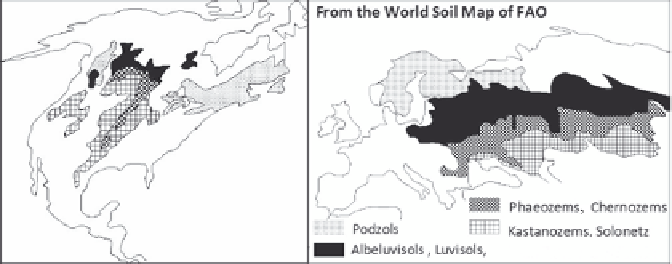Geoscience Reference
In-Depth Information
Fig. 14.3
Distribution of the principal continental soils at the scale of North America, Europe
and Asia; from the FAO map.
for discovering, in the nineteenth century, the climatic zonality of soils!
This remark is not intended to lessen the merits of Dokuchaev but
to underscore the fact that luck is always important in the matter of
scientific discovery. There was at least one precursor to Dokuchaev:
the Frenchman Anatole Leroy-Beaulieu (12 February 1842-5 June 1912),
historian, geographer and essayist. Exactly ten years before Dokuchaev
published his thesis on Russian Tchernozems, Leroy-Beaulieu (1873)
published an article in
Revue des Deux Mondes
. In it he perfectly described
three pedoclimatic bands, that of Chernozems, that of the 'fertile steppes'
(Kastanozems) and that of saline soils of the south (Solonetz).
From Asia and Russia, Chernozems go westward and reach Vienna
(Austria) and very surely up to the central part of Germany (Dultz and
Kühn 2005). In France, soils related to Chernozems are found in two
regions protected from westerly winds by mountainous massifs and
thereby benefiting from particularly dry continental climates (annual
rainfall close to 500 mm). They are found on the one hand in the
Limagne, in the lee of the Monts Dômes and on the other hand,
leeward of the Vosges mountains in the Alsace plain. The areas involved
are small, but the
black soils of Limagne
(local name) are the best soils of
France!
Chernozems have a positive carbon balance. Actually, they are developed
under grassland and this is favourable for the accumulation of humus
(Chap. 2, § 2.5.3). Also, they started their development a long time ago,
at the retreat of the last glaciation (Khokhlova
et al
. 2001). On the other
hand, the cold winters and dry summers of the continental regions do
Genesis



